Abstract
In the presence of 5 microM-DL-propranolol and in HCO3(-)-containing buffers, 1 microM-adrenaline acutely stimulated protein synthesis by about 25% in the anterogradely perfused rat heart. This stimulation was opposed by low (1-10 nM) concentrations of prazosin, but not by similar concentrations of yohimbine, suggesting involvement of the alpha 1-adrenoceptor. Under the same conditions, adrenaline raised intracellular pH (pHi) by about 0.1 unit. The increase in pHi induced by adrenaline was prevented by 5 nM-prazosin, but not by 5 nM-yohimbine, again suggesting involvement of the alpha 1-adrenoceptor. Since an increase in pHi stimulates protein synthesis in the heart [Sugden & Fuller (1991) Biochem. J. 273, 339-346], the increase in pHi induced by adrenaline may be involved in its stimulation of protein synthesis. Adrenaline also increased phosphocreatine concentrations. As discussed, the increase in pHi induced by adrenaline may be responsible for this effect. Using second-order polynomial regression analysis, we showed that rates of protein synthesis were significantly correlated (P less than 0.0001) with phosphocreatine concentrations. We discuss two possible reasons for this correlation: (i) increases in pHi stimulate protein synthesis and separately raise phosphocreatine concentrations, or (ii) the increase in protein synthesis rates is a consequence of the raised phosphocreatine concentrations induced by the increase in pHi. Rates of protein synthesis were not significantly correlated with ATP/ADP concentration ratios, nor with any of the following: ATP, ADP, AMP or total adenine nucleotide concentrations. In freshly isolated adult rat cardiomyocytes, the protein kinase inhibitor staurosporine (1 microM) prevented stimulation of protein synthesis by 0.3 microM-adrenaline (and by 1 microM-phorbol 12-myristate 13-acetate or 1 m-unit of insulin/ml). The results are discussed within a mechanistic framework initiated by stimulation of the hydrolysis of membrane phospholipids by alpha 1-adrenergic agonists.
Full text
PDF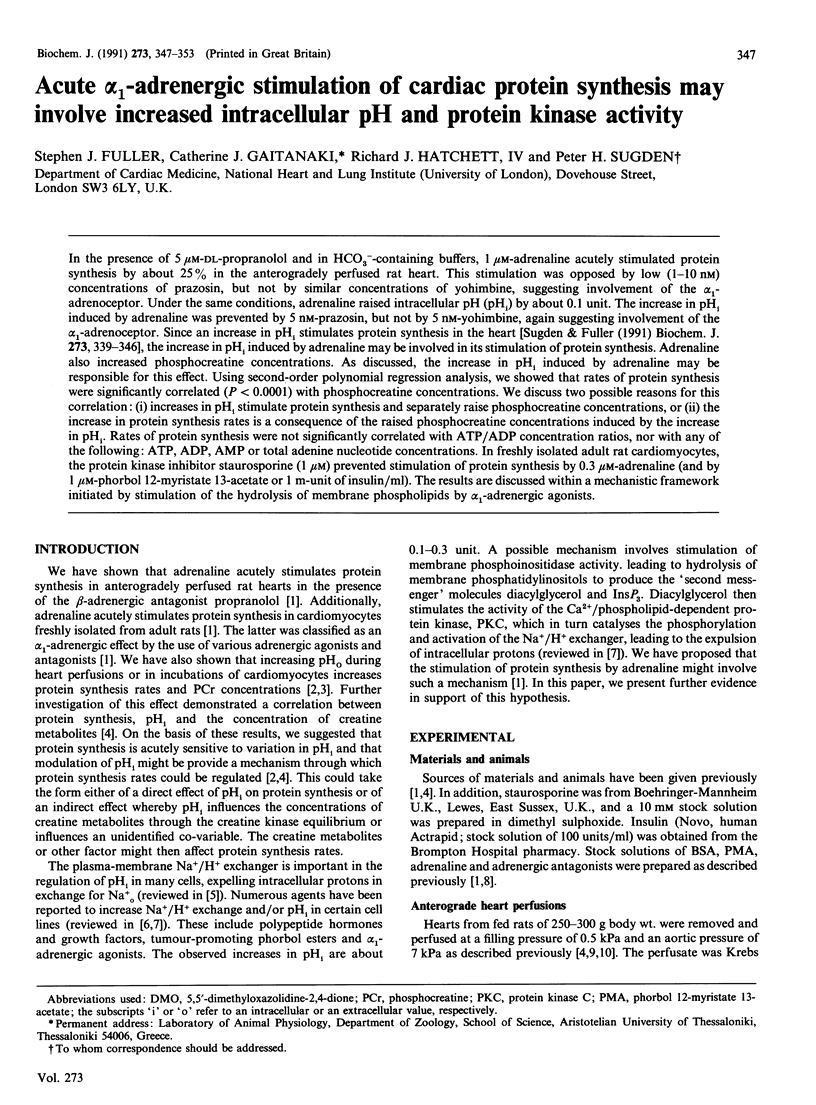
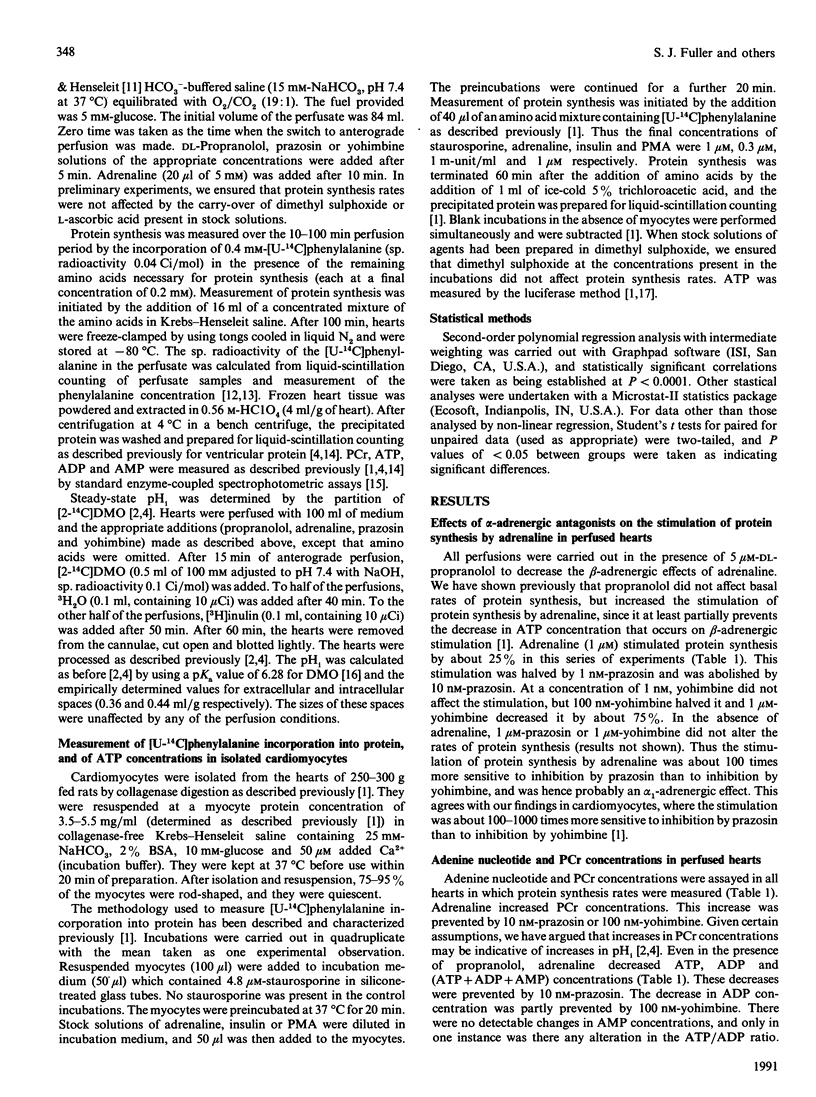
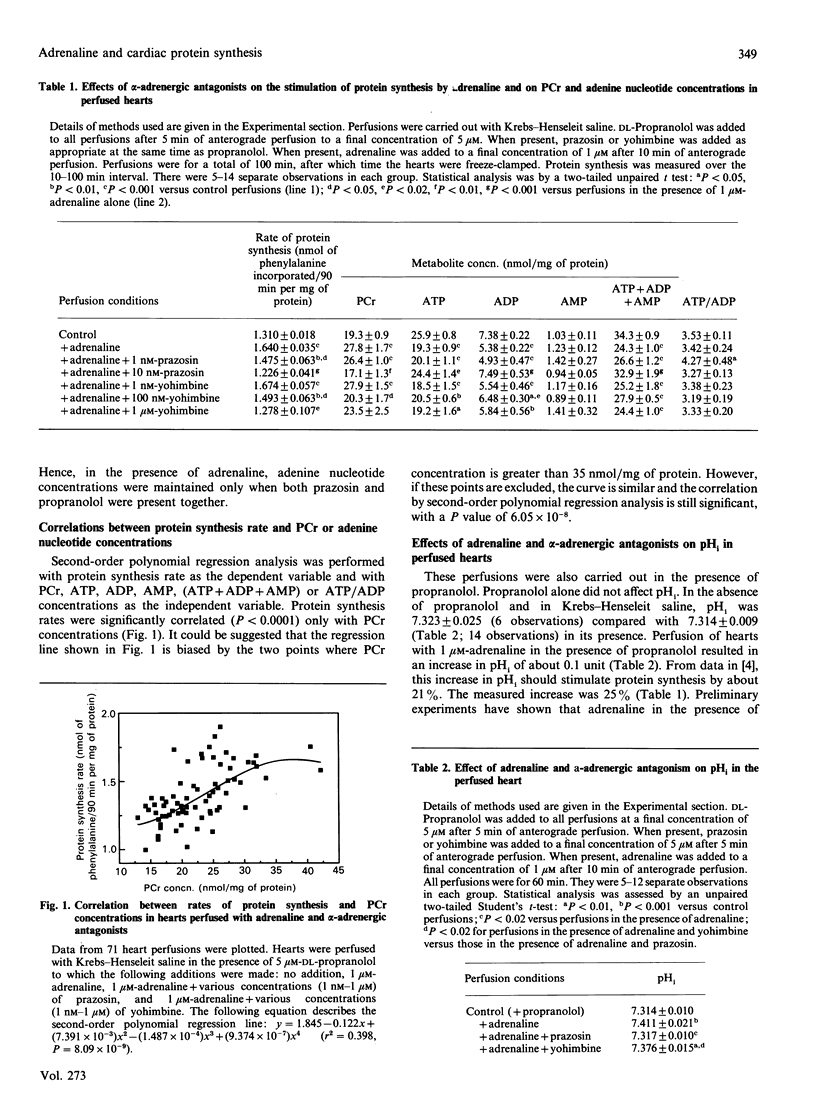
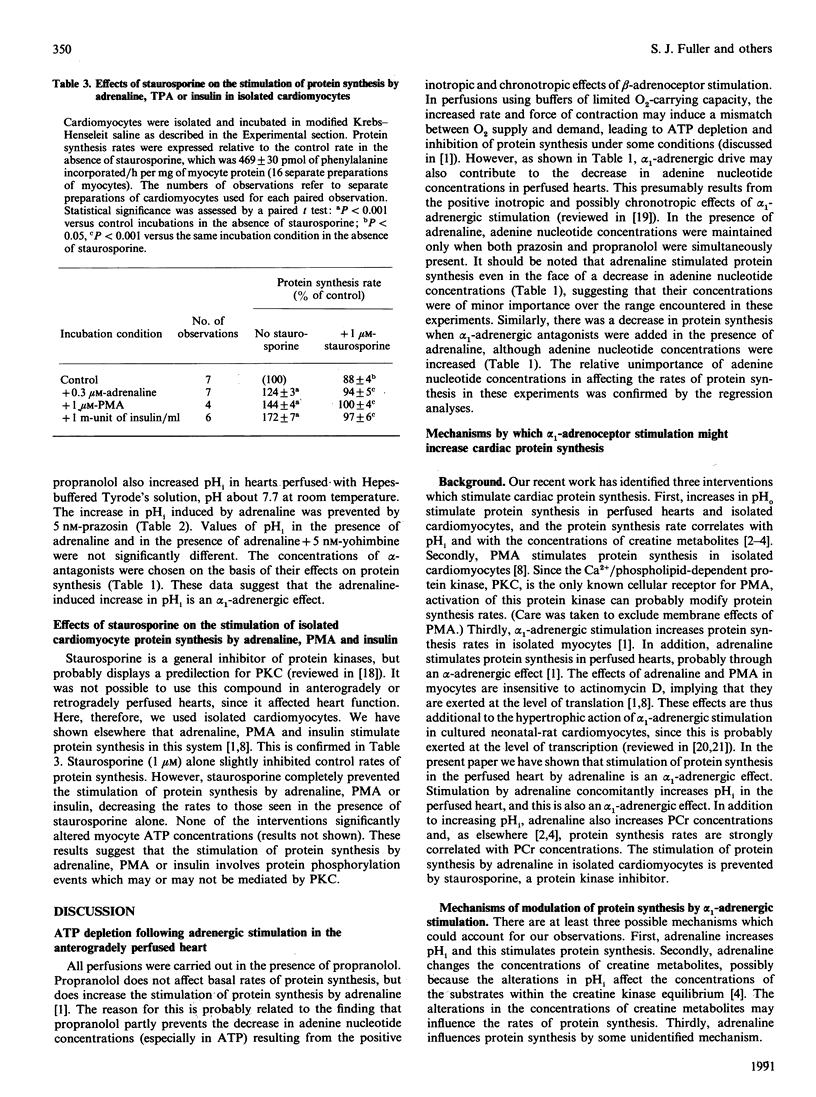
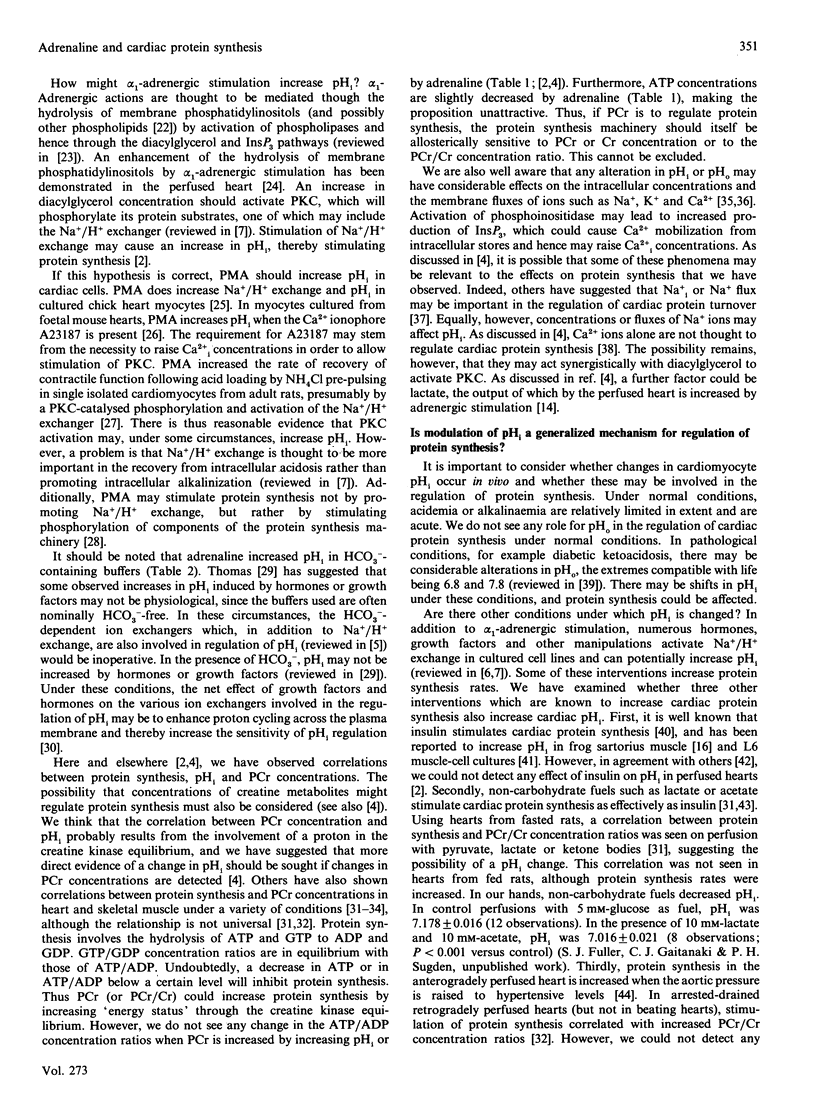
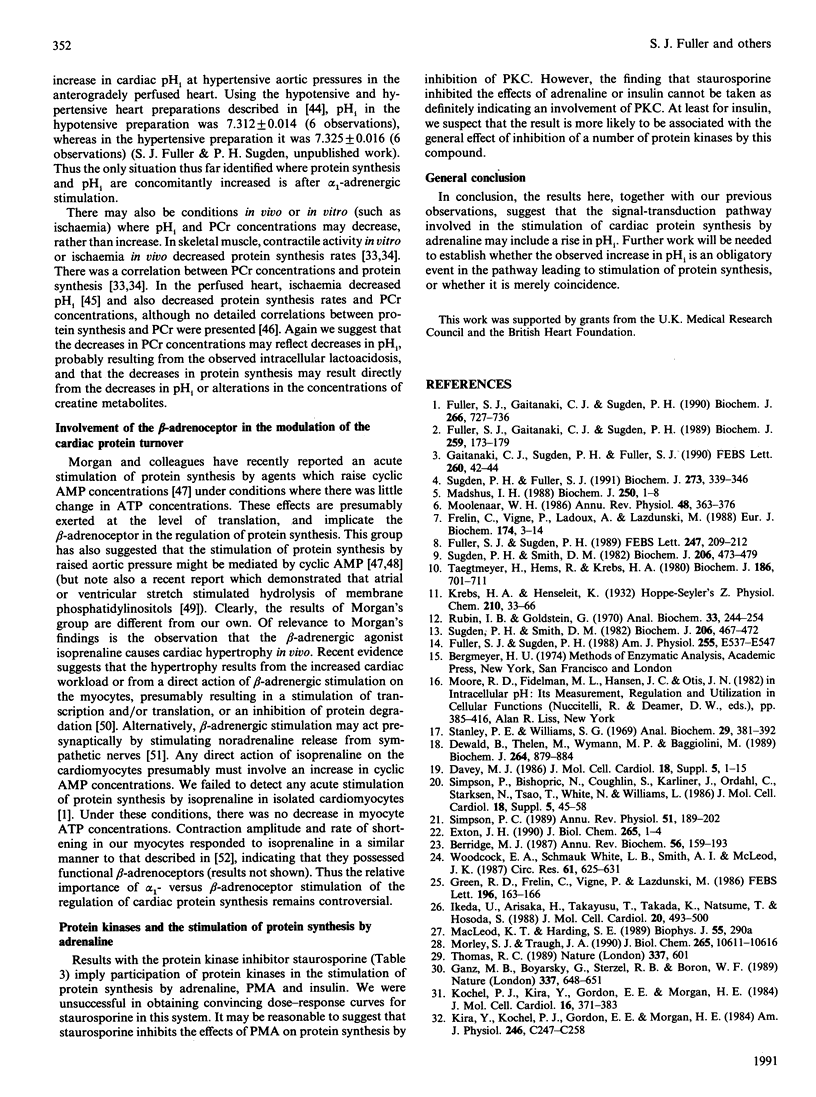
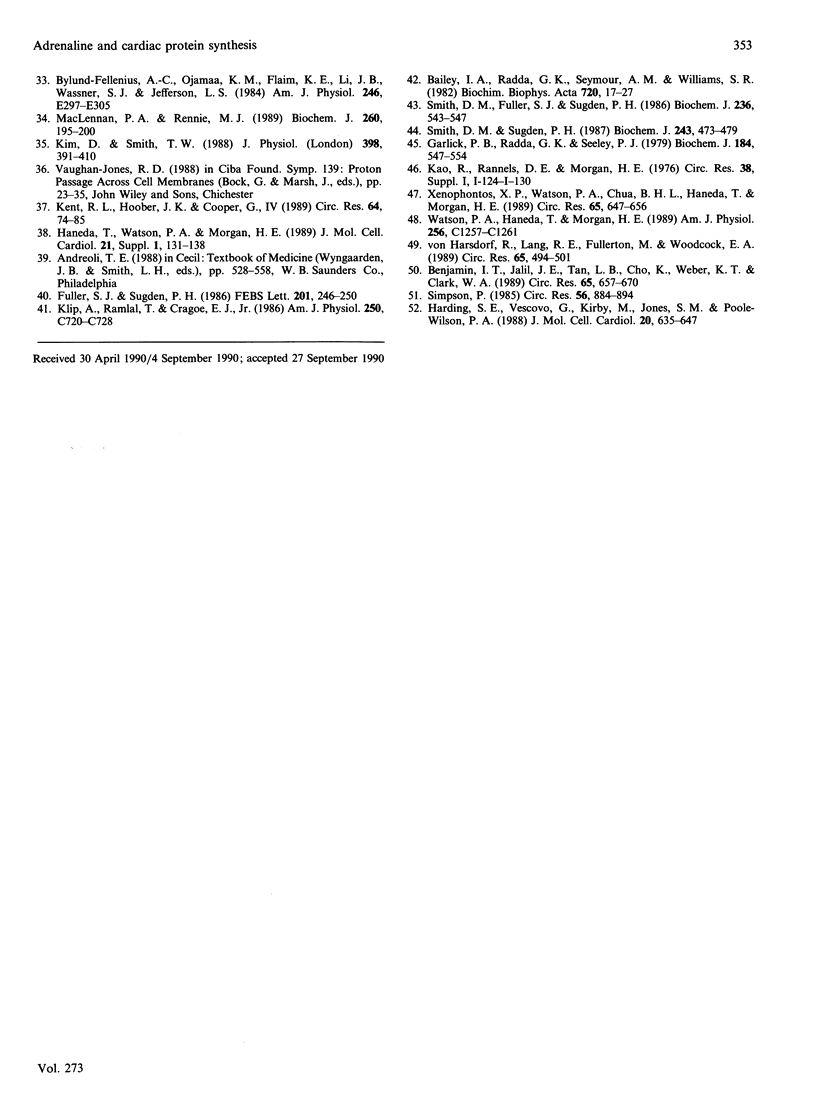
Selected References
These references are in PubMed. This may not be the complete list of references from this article.
- Bailey I. A., Radda G. K., Seymour A. M., Williams S. R. The effects of insulin on myocardial metabolism and acidosis in normoxia and ischaemia. A 31P-NMR study. Biochim Biophys Acta. 1982 Feb 10;720(1):17–27. doi: 10.1016/0167-4889(82)90034-9. [DOI] [PubMed] [Google Scholar]
- Benjamin I. J., Jalil J. E., Tan L. B., Cho K., Weber K. T., Clark W. A. Isoproterenol-induced myocardial fibrosis in relation to myocyte necrosis. Circ Res. 1989 Sep;65(3):657–670. doi: 10.1161/01.res.65.3.657. [DOI] [PubMed] [Google Scholar]
- Berridge M. J. Inositol trisphosphate and diacylglycerol: two interacting second messengers. Annu Rev Biochem. 1987;56:159–193. doi: 10.1146/annurev.bi.56.070187.001111. [DOI] [PubMed] [Google Scholar]
- Bylund-Fellenius A. C., Ojamaa K. M., Flaim K. E., Li J. B., Wassner S. J., Jefferson L. S. Protein synthesis versus energy state in contracting muscles of perfused rat hindlimb. Am J Physiol. 1984 Apr;246(4 Pt 1):E297–E305. doi: 10.1152/ajpendo.1984.246.4.E297. [DOI] [PubMed] [Google Scholar]
- Dewald B., Thelen M., Wymann M. P., Baggiolini M. Staurosporine inhibits the respiratory burst and induces exocytosis in human neutrophils. Biochem J. 1989 Dec 15;264(3):879–884. doi: 10.1042/bj2640879. [DOI] [PMC free article] [PubMed] [Google Scholar]
- Exton J. H. Signaling through phosphatidylcholine breakdown. J Biol Chem. 1990 Jan 5;265(1):1–4. [PubMed] [Google Scholar]
- Frelin C., Vigne P., Ladoux A., Lazdunski M. The regulation of the intracellular pH in cells from vertebrates. Eur J Biochem. 1988 May 16;174(1):3–14. doi: 10.1111/j.1432-1033.1988.tb14055.x. [DOI] [PubMed] [Google Scholar]
- Fuller S. J., Gaitanaki C. J., Sugden P. H. Effects of catecholamines on protein synthesis in cardiac myocytes and perfused hearts isolated from adult rats. Stimulation of translation is mediated through the alpha 1-adrenoceptor. Biochem J. 1990 Mar 15;266(3):727–736. doi: 10.1042/bj2660727. [DOI] [PMC free article] [PubMed] [Google Scholar]
- Fuller S. J., Gaitanaki C. J., Sugden P. H. Effects of increasing extracellular pH on protein synthesis and protein degradation in the perfused working rat heart. Biochem J. 1989 Apr 1;259(1):173–179. doi: 10.1042/bj2590173. [DOI] [PMC free article] [PubMed] [Google Scholar]
- Fuller S. J., Sugden P. H. Acute inhibition of rat heart protein synthesis in vitro during beta-adrenergic stimulation or hypoxia. Am J Physiol. 1988 Oct;255(4 Pt 1):E537–E547. doi: 10.1152/ajpendo.1988.255.4.E537. [DOI] [PubMed] [Google Scholar]
- Fuller S. J., Sugden P. H. Protein synthesis in rat cardiac myocytes is stimulated at the level of translation by phorbol esters. FEBS Lett. 1989 Apr 24;247(2):209–212. doi: 10.1016/0014-5793(89)81336-5. [DOI] [PubMed] [Google Scholar]
- Fuller S. J., Sugden P. H. Stimulation of protein synthesis, glucose uptake and lactate output by insulin and adenosine deaminase in the rat heart. FEBS Lett. 1986 Jun 9;201(2):246–250. doi: 10.1016/0014-5793(86)80617-2. [DOI] [PubMed] [Google Scholar]
- Gaitanaki C. J., Sugden P. H., Fuller S. J. Stimulation of protein synthesis by raised extracellular pH in cardiac myocytes and perfused hearts. FEBS Lett. 1990 Jan 15;260(1):42–44. doi: 10.1016/0014-5793(90)80061-m. [DOI] [PubMed] [Google Scholar]
- Ganz M. B., Boyarsky G., Sterzel R. B., Boron W. F. Arginine vasopressin enhances pHi regulation in the presence of HCO3- by stimulating three acid-base transport systems. Nature. 1989 Feb 16;337(6208):648–651. doi: 10.1038/337648a0. [DOI] [PubMed] [Google Scholar]
- Garlick P. B., Radda G. K., Seeley P. J. Studies of acidosis in the ischaemic heart by phosphorus nuclear magnetic resonance. Biochem J. 1979 Dec 15;184(3):547–554. doi: 10.1042/bj1840547. [DOI] [PMC free article] [PubMed] [Google Scholar]
- Green R. D., Frelin C., Vigne P., Lazdunski M. The activity of the Na+/H+ antiporter in cultured cardiac cells is dependent on the culture conditions used. FEBS Lett. 1986 Feb 3;196(1):163–166. doi: 10.1016/0014-5793(86)80234-4. [DOI] [PubMed] [Google Scholar]
- Haneda T., Watson P. A., Morgan H. E. Elevated aortic pressure, calcium uptake, and protein synthesis in rat heart. J Mol Cell Cardiol. 1989 Feb;21 (Suppl 1):131–138. doi: 10.1016/0022-2828(89)90848-1. [DOI] [PubMed] [Google Scholar]
- Harding S. E., Vescovo G., Kirby M., Jones S. M., Gurden J., Poole-Wilson P. A. Contractile responses of isolated adult rat and rabbit cardiac myocytes to isoproterenol and calcium. J Mol Cell Cardiol. 1988 Jul;20(7):635–647. doi: 10.1016/s0022-2828(88)80121-4. [DOI] [PubMed] [Google Scholar]
- Ikeda U., Arisaka H., Takayasu T., Takeda K., Natsume T., Hosoda S. Protein kinase C activation aggravates hypoxic myocardial injury by stimulating Na+/H+ exchange. J Mol Cell Cardiol. 1988 Jun;20(6):493–500. doi: 10.1016/s0022-2828(88)80076-2. [DOI] [PubMed] [Google Scholar]
- Kent R. L., Hoober J. K., Cooper G., 4th Load responsiveness of protein synthesis in adult mammalian myocardium: role of cardiac deformation linked to sodium influx. Circ Res. 1989 Jan;64(1):74–85. doi: 10.1161/01.res.64.1.74. [DOI] [PubMed] [Google Scholar]
- Kim D., Smith T. W. Cellular mechanisms underlying calcium-proton interactions in cultured chick ventricular cells. J Physiol. 1988 Apr;398:391–410. doi: 10.1113/jphysiol.1988.sp017049. [DOI] [PMC free article] [PubMed] [Google Scholar]
- Kira Y., Kochel P. J., Gordon E. E., Morgan H. E. Aortic perfusion pressure as a determinant of cardiac protein synthesis. Am J Physiol. 1984 Mar;246(3 Pt 1):C247–C258. doi: 10.1152/ajpcell.1984.246.3.C247. [DOI] [PubMed] [Google Scholar]
- Klip A., Ramlal T., Cragoe E. J., Jr Insulin-induced cytoplasmic alkalinization and glucose transport in muscle cells. Am J Physiol. 1986 May;250(5 Pt 1):C720–C728. doi: 10.1152/ajpcell.1986.250.5.C720. [DOI] [PubMed] [Google Scholar]
- Kochel P. J., Kira Y., Gordon E. E., Morgan H. E. Effects of noncarbohydrate substrates on protein synthesis in hearts from fed and fasted rats. J Mol Cell Cardiol. 1984 Apr;16(4):371–383. doi: 10.1016/s0022-2828(84)80608-2. [DOI] [PubMed] [Google Scholar]
- MacLennan P. A., Rennie M. J. Effects of ischaemia, blood loss and reperfusion on rat muscle protein synthesis, metabolite concentrations and polyribosome profiles in vivo. Biochem J. 1989 May 15;260(1):195–200. doi: 10.1042/bj2600195. [DOI] [PMC free article] [PubMed] [Google Scholar]
- Madshus I. H. Regulation of intracellular pH in eukaryotic cells. Biochem J. 1988 Feb 15;250(1):1–8. doi: 10.1042/bj2500001. [DOI] [PMC free article] [PubMed] [Google Scholar]
- Moolenaar W. H. Effects of growth factors on intracellular pH regulation. Annu Rev Physiol. 1986;48:363–376. doi: 10.1146/annurev.ph.48.030186.002051. [DOI] [PubMed] [Google Scholar]
- Morley S. J., Traugh J. A. Differential stimulation of phosphorylation of initiation factors eIF-4F, eIF-4B, eIF-3, and ribosomal protein S6 by insulin and phorbol esters. J Biol Chem. 1990 Jun 25;265(18):10611–10616. [PubMed] [Google Scholar]
- Rubin I. B., Goldstein G. An ultrasensitive isotope dilution method for the determination of L-amino acids. Anal Biochem. 1970 Feb;33(2):244–254. doi: 10.1016/0003-2697(70)90293-9. [DOI] [PubMed] [Google Scholar]
- Simpson P. C. Proto-oncogenes and cardiac hypertrophy. Annu Rev Physiol. 1989;51:189–202. doi: 10.1146/annurev.ph.51.030189.001201. [DOI] [PubMed] [Google Scholar]
- Simpson P., Bishopric N., Coughlin S., Karliner J., Ordahl C., Starksen N., Tsao T., White N., Williams L. Dual trophic effects of the alpha 1-adrenergic receptor in cultured neonatal rat heart muscle cells. J Mol Cell Cardiol. 1986 Nov;18 (Suppl 5):45–58. doi: 10.1016/s0022-2828(86)80460-6. [DOI] [PubMed] [Google Scholar]
- Simpson P. Stimulation of hypertrophy of cultured neonatal rat heart cells through an alpha 1-adrenergic receptor and induction of beating through an alpha 1- and beta 1-adrenergic receptor interaction. Evidence for independent regulation of growth and beating. Circ Res. 1985 Jun;56(6):884–894. doi: 10.1161/01.res.56.6.884. [DOI] [PubMed] [Google Scholar]
- Smith D. M., Fuller S. J., Sugden P. H. The effects of lactate, acetate, glucose, insulin, starvation and alloxan-diabetes on protein synthesis in perfused rat hearts. Biochem J. 1986 Jun 1;236(2):543–547. doi: 10.1042/bj2360543. [DOI] [PMC free article] [PubMed] [Google Scholar]
- Smith D. M., Sugden P. H. Effects of pressure overload and insulin on protein turnover in the perfused rat heart. Prostaglandins are not involved although their synthesis is stimulated by insulin. Biochem J. 1987 Apr 15;243(2):473–479. doi: 10.1042/bj2430473. [DOI] [PMC free article] [PubMed] [Google Scholar]
- Stanley P. E., Williams S. G. Use of the liquid scintillation spectrometer for determining adenosine triphosphate by the luciferase enzyme. Anal Biochem. 1969 Jun;29(3):381–392. doi: 10.1016/0003-2697(69)90323-6. [DOI] [PubMed] [Google Scholar]
- Sugden P. H., Fuller S. J. Correlations between cardiac protein synthesis rates, intracellular pH and the concentrations of creatine metabolites. Biochem J. 1991 Jan 15;273(Pt 2):339–346. doi: 10.1042/bj2730339. [DOI] [PMC free article] [PubMed] [Google Scholar]
- Sugden P. H., Smith D. M. The effects of glucose, acetate, lactate and insulin on protein degradation in the perfused rat heart. Biochem J. 1982 Sep 15;206(3):467–472. doi: 10.1042/bj2060467. [DOI] [PMC free article] [PubMed] [Google Scholar]
- Sugden P. H., Smith D. M. The effects of insulin on glucose uptake and lactate release in perfused working rat heart preparations. Biochem J. 1982 Sep 15;206(3):473–479. doi: 10.1042/bj2060473. [DOI] [PMC free article] [PubMed] [Google Scholar]
- Taegtmeyer H., Hems R., Krebs H. A. Utilization of energy-providing substrates in the isolated working rat heart. Biochem J. 1980 Mar 15;186(3):701–711. doi: 10.1042/bj1860701. [DOI] [PMC free article] [PubMed] [Google Scholar]
- Thomas R. C. Cell growth factors. Bicarbonate and pHi response. Nature. 1989 Feb 16;337(6208):601–601. doi: 10.1038/337601a0. [DOI] [PubMed] [Google Scholar]
- Watson P. A., Haneda T., Morgan H. E. Effect of higher aortic pressure on ribosome formation and cAMP content in rat heart. Am J Physiol. 1989 Jun;256(6 Pt 1):C1257–C1261. doi: 10.1152/ajpcell.1989.256.6.C1257. [DOI] [PubMed] [Google Scholar]
- Woodcock E. A., White L. B., Smith A. I., McLeod J. K. Stimulation of phosphatidylinositol metabolism in the isolated, perfused rat heart. Circ Res. 1987 Nov;61(5):625–631. doi: 10.1161/01.res.61.5.625. [DOI] [PubMed] [Google Scholar]
- Xenophontos X. P., Watson P. A., Chua B. H., Haneda T., Morgan H. E. Increased cyclic AMP content accelerates protein synthesis in rat heart. Circ Res. 1989 Sep;65(3):647–656. doi: 10.1161/01.res.65.3.647. [DOI] [PubMed] [Google Scholar]
- von Harsdorf R., Lang R. E., Fullerton M., Woodcock E. A. Myocardial stretch stimulates phosphatidylinositol turnover. Circ Res. 1989 Aug;65(2):494–501. doi: 10.1161/01.res.65.2.494. [DOI] [PubMed] [Google Scholar]


